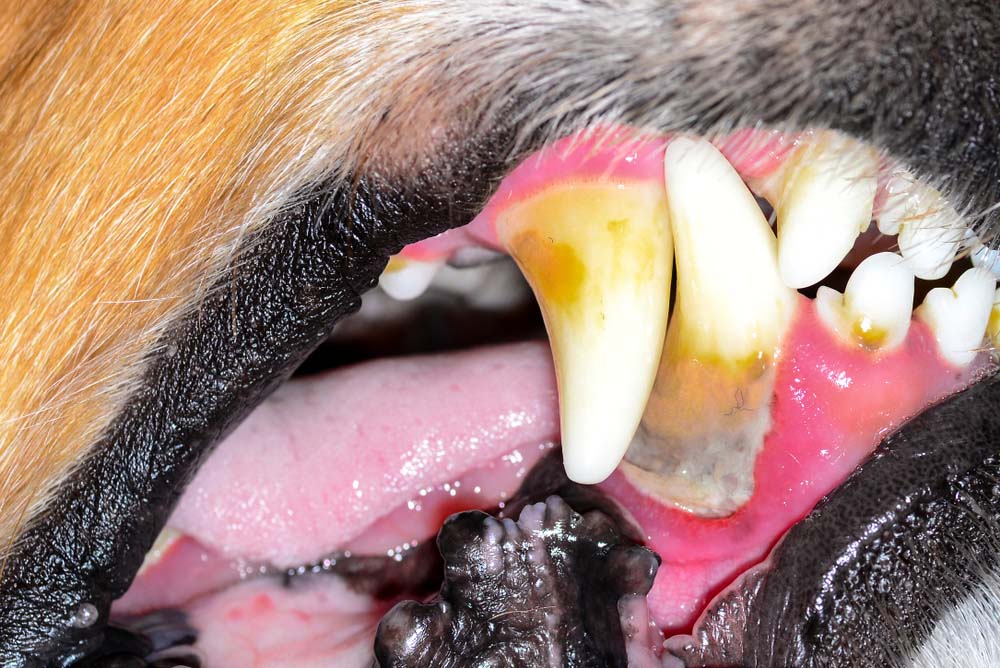Periodontal disease is the most common health condition seen in adult dogs. Estimated prevalence can be as high as 80%. Sadly, it's also the most preventable. The majority of pet owners don't realize that regular dog teeth brushing could add years to a dog's life. If you're wondering how often to brush dog's teeth, you're in the right place.
Table of Contents
Most people assume that dogs just naturally have bad breath, but that's actually a common misconception. Most dogs will begin showing signs of periodontal disease by the time they are 3 years old. The buildup of plaque and tartar in a dog's mouth fosters the growth of bacteria, which leads to bad breath.
Keeping up with your dog's oral hygiene will not only reduce bad breath, but also aid in a dog's overall health and well-being. Many diseases are associated with dental health in dogs. For example, if you don't brush your dog's teeth, it could lead to conditions like:
- destruction to and loss of the gum tissue and bone around the teeth;
- fistulas (holes leading from the oral cavity to the nasal passage);
- osteomyelitis (bone infection);
- weakened jaw bone;
- bacteria in bloodstream and negative effects on the heart, liver and kidneys.
I've explained before how to effectively and easily brush a dog's teeth. In this video above and the below guide, I will explain how often to brush dog's teeth, among other things.
How Often to Brush Dog's Teeth
 1. How to Brush a Dog's Teeth
1. How to Brush a Dog's Teeth
Brushing a dog's teeth isn't difficult once you get your pet used to the idea. It's similar to brushing your own teeth. Here's the process explained in a few quick steps.
(1) First, get a dog-friendly toothpaste and toothbrush.
(2) Start by brushing one or two teeth at a time, whatever your dog will let you do. The front side of the back teeth and the canine teeth should be your first priority.
(3) Dogs have a rough tongue. It helps to scrape some of the plaque off of the interior of their teeth. The interiors still need to be brushed, but in the beginning, you can focus on the outside of the dog's teeth and their canines.
(4) Apply slight pressure and move the brush in small circles. Just like when you brush your own teeth, if you apply too much pressure, you could damage your pet's gums. Brushing at a 45° angle will allow the toothbrush to clean the gums and teeth properly.
(5) Dog toothpaste does not require rinsing like toothpaste for humans. Once you've brushed your pet's teeth for about 2-3 minutes, you can simply let the dog lick the remaining toothpaste off his teeth and your task is finished.
2. How Often to Brush Dog's Teeth
Obviously, it's best to brush a dog's teeth on a daily basis – once a day.
Ideally, you should brush his teeth in the evening after dog's final meal of the day. This will help to scrape off any plaque or bacteria that has built up over the course of the day.
If you don't have time to brush your dog's teeth every single day, most veterinary dental experts recommend brushing your dog's teeth at least 3 times per week. This will drastically help to prevent any serious dental diseases in dogs.
You should also have your dog's teeth cleaned professionally once per year at a veterinary clinic. Discuss this treatment with your veterinarian. They can talk you through the procedure and give you an estimate on how much dog's dental cleaning will cost.
3. In Addition to Brushing Your Dog's Teeth…
While none of the other dog teeth cleaning options should replace brushing teeth with a toothpaste and toothbrush, there are a few things you can do in addition to that. This will help to keep your dog's teeth cleaner and healthier, especially if you only brush them 3 times per week.
(1) Dental chews. Most pet owners give their dogs treats once in a while. If you do, choose dental treats which are designed to scrape the dog's teeth and help prevent plaque and tartar.
(2) Water additives. These can be added to your dog's water. Dog dental water additives are non-toxic and can be swallowed by the dog. When the dog drinks, they help to kill off bacteria and keep the teeth cleaner.
(3) Dental gels. Similar to a toothpaste, dog dental gels need to be spread over your dog's teeth. However, they're much easier to use because you only spread them once and leave, and there's no brushing involved. The gel works on its own.
All three of these dental products, especially if you combine them all and use alongside regular teeth brushing, will help to keep your dog's teeth healthier and prevent diseases.
READ NEXT: Dog Teeth Whitening – Here Are Your Options












